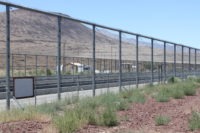Tuesday’s Inyo County Board of Supervisors’ meeting reconvened from the administration building in Independence to Fish Springs Fish Hatchery to get a first-hand look at the impact ofpumping on what was once a source of native fish for the Big Pine Paiute Tribe.
The Supervisors, staff, tribal members and interested locals headed to the hatchery but could not enter the premises due to the presence of lactococcus garvieae. The bacterial infection first appeared in Eastern Sierra hatcheries in 2020, then made a comeback this summer. Infected fish are being euthanized; an inoculation has been developed to combat the disease.
Sally Manning, the tribal environmental director, and Noah Williams, water program coordinator, made their case at the meeting. Fish Springs went dry after the two wells were activated in 1970. The five-acre pond adjacent to the hatchery is now dry and those on the tour had to guess where the pond’s original boundaries were.
Two Los Angeles Department of Water and Power wells now provide water to the hatchery, which was once spring fed. The wells pump 20,000 acre-feet a year. The water from those wells circulate back to the Owens River. When the hatchery operation was shut down during the initial bacterial infection, the water table in the area rose four to eight feet.
Manning made the point that if the water was discharged onto the surrounding terrain, it would restore the landscape, end up in the aquifer and eventually make its way to Los Angeles.
Adam Perez, LADWP’s aqueduct manager, called in during the meeting. While open to the discussion, he could not make any commitments.
The California Department of Fish and Wildlife, the hatchery managing agency, indicated water use could be reduced by 12-percent. But, the tribal goals are to see the springs run, a more diverse habitat and restoration of cultural resources. CDFW’s Dan Tonseth, hatchery manager, attending the meeting via Zoom, told the Board water savings could be achieved.
The department has made contact with vendors, money has been allocated but it will be several years until any improvements can be done.
In response to the strong support from meeting attendees, Leslie Chapman, Inyo’s Chief Administrative Officer, said “The Tribe is asking for support; we’re not being asked to solve the
problem.”
Tribal member Ross Stone addressed the hatchery tour on site. He told stories of hisgrandfather, who lived near the springs, and father fishing in the ponds. “The native fish weremuch better” than the planted trout, he maintained. The Tribe wants to see more than the 12-percent reduction in pumping. They want to see the springs brought back to life.



















Trout fishing in the Eastern Sierra is a subsidized industry. Which is fine but it sure would be nice if Inyo/Mono county shores were not littered with line and hooks.
BTW, Funny I get thumbs down for asking a question, was it a politically incorrect question?
Right? I notice people get thumbs down all the time just for asking innocent questions. They are merely information-gathering type questions. People are weird. Don’t worry about it.
The thumbs down was because locals protect the sanctity of their favorite invasive fish like a cult. I believe Fish Springs should be returned to it’s natural state.
I’m also curious what “native” fish his grandfather fished for that were so superior. I realize people are trying to be politically correct by listening to the tribe’s pipe dream of returning some aspects of the valley back to how some remember it. But I wish DWP and DFW would… Read more »
What native fish are they talking about?
Stone ran thru a list–included pup fish. I couldn’t take notes fast enough to get them all down. He was referencing fish when his granddad and dad were fishing at the pond.
There were only 4 species of fish native to the valley when us knucklehead europeans got here and started tossing non native fish in every lake river and stream they could find. Still, I very much doubt 2.5″ pupfish and Owens Suckers were the highly prized game fish and table… Read more »
Native fish would have been the Owens Sucker (Catostomus fumeiventris) and Owens Chub(Siphateles bicolor snyderi). As far as I know the chub does not exist in nature anymore due to hybridization caused in big part by CDFG planting operations.
Dear Deborah, maybe you could find out what kind of fish, besides pupfish. They are so small I can’t imagine eating them, unless you fried them up whole and ate them like popcorn but I don’t see how that compares to trout. Thanks
I’d much rather of eaten Yellow legged Frogs.
There are four species of native fish in the valley- Owens Pupfish, Owens Sucker, Speckled Dace, and Owens Tui Chub. Sucker and Chub are the only ‘large’ species native to the valley, but there are anecdotal records that pupfish were a food source for natives as well.
When did the Crawfish show up or were they always here?